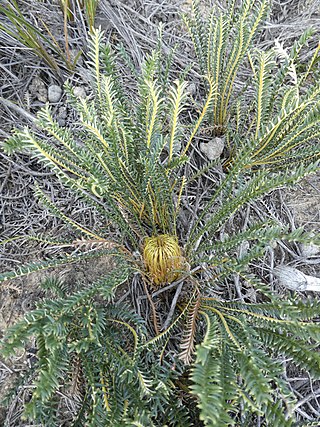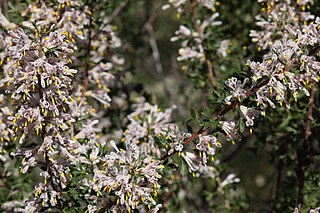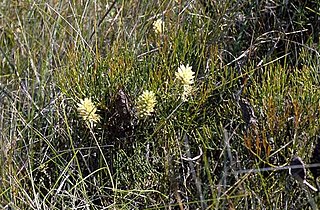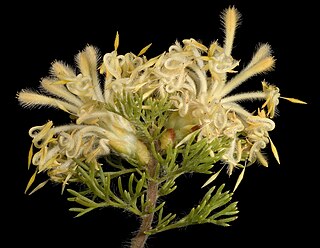
Banksia arctotidis is a species of prostrate shrub that is endemic to the southwest of Western Australia. It has leaves that are pinnately divided to the midrib, cream-coloured flowers and hairy, egg-shaped fruit.

Banksia bipinnatifida is a species of shrub that is endemic to Western Australia. It is a prostrate shrub with a lignotuber, an underground stem, only a few divided leaves, large cream-coloured to pale yellow flowers and large fruit.

Isopogon dubius, commonly known as pincushion coneflower, is a species of plant in the family Proteaceae and is endemic to the south-west of Western Australia. It is a shrub with sharply-pointed, deeply lobed or pinnate leaves and more or less spherical heads of pink to reddish pink flowers.

Petrophile linearis, commonly known as pixie mops, is a species of flowering plant in the family Proteaceae and is endemic to southwestern Western Australia. It is a shrub with narrow egg-shaped leaves, the narrower end towards the base, and oval to spherical heads of hairy, greyish-pink or mauve to almost white flowers.

Petrophile biloba, commonly known as granite petrophile, is a species of flowering plant in the family Proteaceae and is endemic to the south-west of Western Australia. It is a shrub with pinnately-divided leaves with sharply-pointed tips, and oval heads of hairy, mostly grey to pink flowers.

Petrophile macrostachya is a species of flowering plant in the family Proteaceae and is endemic to southwestern Western Australia. It is an erect shrub with prickly, pinnate or lobed leaves, and oblong or cylindrical heads of glabrous yellow to cream-coloured flowers.

Petrophile shirleyae is a species of flowering plant in the family Proteaceae and is endemic to Queensland. It is a shrub with pinnate, needle-shaped, sharply-pointed leaves, and narrow oval heads of silky-hairy white to pale cream-coloured flowers.

Isopogon trilobus, commonly known as barrel coneflower, is a species of flowering plant in the family Proteaceae and is endemic to South Coast Western Australia. It is a shrub with wedge-shaped leaves with lobed or toothed leaves, and oval, spherical or barrel-shaped heads of cream-coloured to yellow flowers.

Petrophile canescens, commonly known as conesticks, is a species of flowering plant in the family Proteaceae and is endemic to eastern Australia. It is an erect shrub with pinnately-divided leaves and oval heads of hairy, white to pale cream-coloured flowers.
Persoonia striata is a species of flowering plant in the family Proteaceae and is endemic to the south-west of Western Australia. It is an erect, often spreading shrub with hairy young branchlets, linear to spatula-shaped leaves, and bright yellow flowers borne in groups of up to five on a rachis up to 2 mm (0.079 in) long that continues to grow after flowering.

Grevillea triternata is species of flowering plant in the family Proteaceae and is endemic to New South Wales. It is a dense, compact shrub with divided leaves, the end lobes sharply pointed, linear to narrowly triangular, and cylindrical clusters of white flowers with a cream-coloured to pale yellow style.

Isopogon divergens, commonly known as spreading coneflower, is a species of plant in the family Proteaceae and is endemic to the south-west of Western Australia. It is a shrub with pinnate leaves and more or less spherical heads of glabrous pink flowers followed by an oval to cylindrical fruiting cone.

Hakea macrocarpa, commonly known as flat-leaved hakea, is a species of flowering plant in the family Proteaceae and is endemic to northern Australia. It is a tree or shrub with furrowed bark, woolly-hairy branchlets, narrowly linear leaves and cream-coloured to greenish-yellow flowers.

Petrophile anceps is a species of flowering plant in the family Proteaceae and is endemic to a restricted part of the south-west of Western Australia. It is a shrub with sharply-pointed, linear leaves and oval heads of hairy yellow flowers.
Petrophile crispata is a species of flowering plant in the family Proteaceae and is endemic to southwestern Western Australia. It is a shrub with pinnately-divided leaves with sharply-pointed tips, and oval heads of glabrous, yellow flowers.

Petrophile divaricata is a species of flowering plant in the family Proteaceae and is endemic to southwestern Western Australia. It is a shrub with bipinnate, sharply-pointed leaves, and oval to oblong heads of hairy, yellow flowers.

Petrophile ericifolia is a species of flowering plant in the family Proteaceae and is endemic to southwestern Western Australia. It is a shrub with cylindrical leaves, and oval to spherical heads of hairy, yellow flowers.

Petrophile heterophylla, commonly known as the variable-leaved conebush, is a species of flowering plant in the family Proteaceae and is endemic to southwestern Western Australia. It is a shrub with variably shaped, sometimes pinnately-divided leaves, and oval heads of silky-hairy, yellow to cream-coloured flowers.

Petrophile media is a species of flowering plant in the family Proteaceae and is endemic to southwestern Western Australia. It is a low, spreading to erect shrub with needle-shaped leaves, and oval heads of hairy cream-coloured to yellow flowers.

Petrophile serruriae is a species of flowering plant in the family Proteaceae and is endemic to southwestern Western Australia. It is a shrub with crowded, pinnate, needle-shaped, sharply-pointed leaves, and oval heads of silky-hairy yellow, greyish mauve to pink flowers.


















